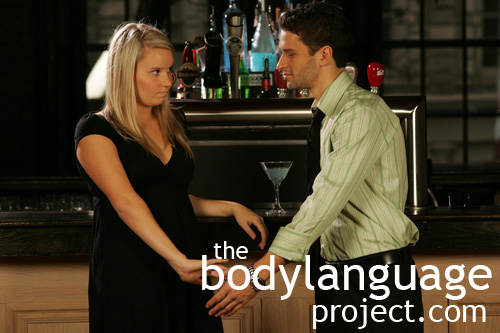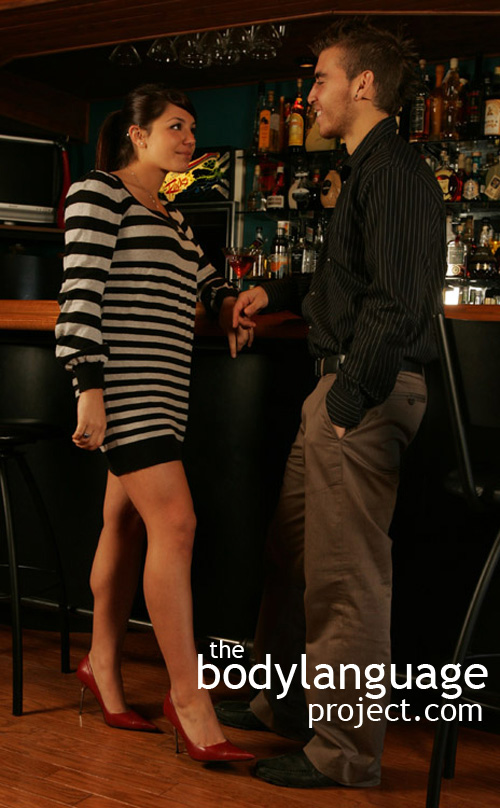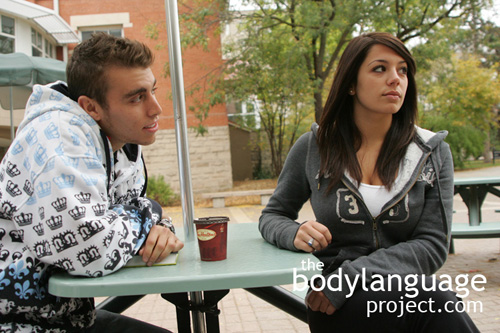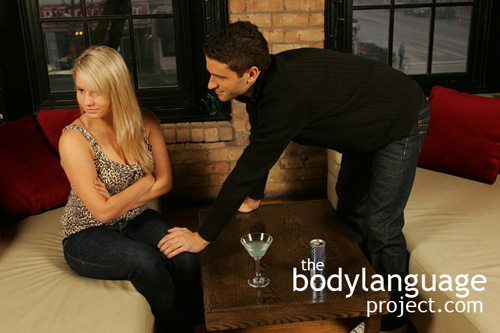Body Language of Touch Reduction
 Cue: Touch Reduction.
Cue: Touch Reduction.
Synonym(s): Reduced Touching.
Description: Touching between two people is either stopped abruptly or stopped gradually over time.
In One Sentence: Touch reduction indicates a difference of opinion or anxiety.
How To Use it: When you wish to send the signal that you disapprove, create space between you and the person you object to. This can easily be done through touch reduction, especially if it is done suddenly. Reducing touch is especially potent between couples and family members, as touching is usually much more frequent in these close associations. During a disagreement, pulling the hands inward and away from your partner tells them that you want them to change their stance on matters. Reducing or eliminating touching is the nonverbal signal for emotional withdrawal. Therefore, the signal is considered an honest marker for your thoughts and feelings.
Context: a) General b) Dating.
Verbal Translation: “I’m not in agreement with you. I’m putting up and maintaining space between the both of us serving to demonstrate nonverbally our differences of opinion.”
Variant: See Arm Withdrawal or Leg Withdrawal, Touching or Increase In Touching.
Cue In Action: a) Mom wanted her son to stop being so rambunctious, but he wouldn’t listen. Then the inevitable happened – he fell and skinned his knee. Ordinarily she would comfort him immediately, but she refused. She displayed her disapproval nonverbally. b) Instead of sitting tightly together on the same side of the sofa and snuggle as they usually would, the couple sat at opposite ends. They had a tiff and didn’t want to be close to one another.
Meaning and/or Motivation: It should be noted that ‘touch reduction’ is also a sudden change in ‘touch frequency.’ Couples have even been shown to draw away from each other when they are generally unhappy with their relationship.
Touch reduction is usually accompanied with stressful situations therefore signaling anxiety. We may see touch reduction during intense interrogation and may accompany compelling or damning information.
Closeness can also be useful when assessing someone because it will invoke distancing desires. When talking with a spouse or child, sit as close to them as you are accustomed to. Then take up serious matters. If someone is hiding something, they will usually push away or even stand up looking for ways to exit or change the subject. Holding the hand of a child can be particularly useful when discussing matters of dishonesty. If they wish to exit the discussion, they will try to tug their hand away [note: trying to withdraw is not a signal of culpability, but it is a signal of anxiety through a desire for distance].
Liars rarely touch others when they lie to them as this is a natural part of the fight or flight response. During intense interactions the subconscious mind does not respond well to intimacy caused by touching. This can prove helpful in intimate relationships, with family members or children since touching is a normal part of everyday life. Any form of touch reduction can signal that a person is at odds with another and that they might be hiding something.
If touch isn’t normal, for example, between strangers or acquaintances, then measuring touch reduction won’t be possible. In this case, look for distancing behaviours instead such as arm withdrawal or leaning away, especially in the torso, as these are also forms of distancing.
Cue Cluster: Touch reduction is usually accompanied by leaning away, ventral denial, head back or away, eyes averted, reduction in movement or freezing behaviour, reduction in verbal communication and so forth.
Body Language Category: Amplifier, Anger body language, Disengagement body language, Dislike (nonverbal), Disapproval cues, Distancing or moving away, Emotional body language, Indicators of disinterest (IOD).
Resources:
Argo, J. J., Dahl, D. W., & Morales, A. C. (2006). Consumer contamination: How consumers react to products touched by others. Journal of Marketing, 70(April), 81–94.
Aranguren, Martin. “Nonverbal interaction patterns in the Delhi Metro: interrogative looks and play-faces in the management of interpersonal distance.” Interaction Studies. 2016. 16(1) forthcoming.
Aranguren, Martin. “Nonverbal interaction patterns in the Delhi Metro: interrogative looks and play-faces in the management of interpersonal distance.” Interaction Studies. 2016. 16(1) forthcoming.
Aranguren, Martin and Stephane Tonnelat. Emotional Transactions in the Paris Subway: Combining Naturalistic Videotaping, Objective Facial Coding and Sequential Analysis in the Study of Nonverbal Emotional Behavior. Journal of Nonverbal Behavior. 2014. 38:495–521. DOI 10.1007/s10919-014-0193-1
http://bodylanguageproject.com/articles/seriously-stop-touching-use-nonverbal-signaling-manage-unwanted-touching-busy-public
Bailenson, J.N. & Yee, N. (in press). Virtual interpersonal touch: Haptic interaction and copresence in collaborative virtual environments. International Journal of Multimedia Tools and Applications.
Bohm. 1997. Effects of interpersonal touch, degree of justification, and sex of participant on compliance with a request. The Journal of social psychology. 137: 460-469.
Crusco, A. and C. Wetzel. 1984. The midas touch: the effects of interpersonal touch on restaurant tipping, Personality and Social Psychology Bulletin 10: 512–517.
Dickinson, Amy. Block That Hug: The rules on touching children have changed for parents who volunteer as coaches or tutors.(Personal Time/Your Family)(Brief Article). Time. 2000. 155(14): 142.
Debrot, Anik ; Schoebi, Dominik ; Perrez, Meinrad ; Horn, Andrea B. Touch as an interpersonal emotion regulation process in couples’ daily lives: the mediating role of psychological intimacy. Personality & social psychology bulletin. 2013. 9(10): 1373-85.
Derlega, Valerian ; Lewis, Robin ; Harrison, Scott ; Winstead, Barbara ; Costanza, Robert. Gender differences in the initiation and attribution of tactile intimacy. Journal of Nonverbal Behavior. 1989. 13(2): 83-96.
Derlega, Valerian J. ; Catanzaro, Diane ; Lewis, Robin J. Lisak, David (editor). Perceptions About Tactile Intimacy in Same-Sex and Opposite-Sex Pairs Based on Research Participants’ Sexual Orientation. Psychology of Men & Masculinity, 2001, Vol.2(2), pp.124-132
Fisher, J; Rytting, M and Heslin, R. 1976. Hands touching hands: affective and evaluative effects on interpersonal touch, Sociometry 39: 416–421.
Feldman, R., Singer, M.,& Zagoory, O. (2010). Touch attenuates infants’ physiological reactivity to stress. Developmental Science, 13(2), 271–278.
Fromme, Donald ; Jaynes, William ; Taylor, Deborah ; Hanold, Elaine ; Daniell, Jennifer ; Rountree, J. ; Fromme, Marie. Nonverbal behavior and attitudes toward touch. Journal of Nonverbal Behavior. 1989. 13(1): 3-14.
Floyd, Kory. All Touches are not Created Equal: Effects of Form and Duration on Observers’ Interpretations of an Embrace. Journal of Nonverbal Behavior. 1999. 23(4): 283-299.
Guéguen, Nicolas. Nonverbal encouragement of participation in a course: the effect of touching Social Psychology of Education. 2004. 7: 89–98.
http://bodylanguageproject.com/articles/a-touching-way-to-encourage/
Gueguen, Nicolas; Sebastien Meineri and Virginie Charles-Sire. Improving Medication Adherence by Using Practitioner Nonverbal Techniques: A Field Experiment on the Effect of Touch. Journal of Behavioral Medice. 2010. 33:466–473
DOI 10.1007/s10865-010-9277-5
http://bodylanguageproject.com/articles/touching-boosts-compliance-improving-medical-compliance-using-nonverbal-communication/
Guéguen, N. (2001a). Toucher et soumission a` une requeˆte: Re´plications expe´rimentales en situation naturelle et e´valuation de l’impact du statut. Revue Internationale de Psychologie Sociale. 2001(a). 14(3):113-158.
Guéguen, N. (2001b). L’effet d’influence du toucher sur le comportement du consommateur: 2 illustrations expe´rimentales en exte´rieur. Direction et Gestion: La Revue des Sciences de Gestion. 2001(b). 190–191, 123–132.
Guéguen, N and C. Jacob 2006, Touch and consumer behavior: A new experimental evidence in a field setting, International Journal of Management 23: 24–33.
Guéguen, N., & Jacob, C. The effect of touch on tipping: An evaluation in a French’s bar. International Journal of Hospitality Management. 2005. 24(2): 295-299.
Gueguen, Nicolas; Celine Jacob; Gaelle Boulbry. The Effect of Touch on Compliance With a Restaurant’s Employee Suggestion. Hospitality Management. 2007. 26: 1019-1023.
http://bodylanguageproject.com/articles/touching-leads-compliance-study/
Guéguen, N. (2007). Courtship compliance: The effect of touch on women’s behavior. Social Influence, 2, 81-97.
Gueguen, Nicolas. The effect of a woman’s incidental tactile contact on men’s later behavior.(Report). Social Behavior and Personality: an international journal. 2010. 38(2): 257(10).
Guéguen, Nicolas. Nonverbal encouragement of participation in a course: the effect of touching Social Psychology of Education. 2004. 7: 89–98.
http://bodylanguageproject.com/articles/a-touching-way-to-encourage/
Gulledge, Andrew K ; Stahmann, Robert F ; Wilson, Colwick M. Seven types of nonsexual romantic physical affection among Brigham young university students
Psychological reports 2004, Vol.95(2), pp.609-14
Gulledge, Andrewk. ; Gulledge, Michelleh. ; Stahmannn, Robertf. Romantic Physical Affection Types and Relationship Satisfaction. The American Journal of Family Therapy, 2003, Vol.31(4), p.233-242
Gurevitch, Z. D. The Embrace: On the Element of Non-Distance in Human Relations. The Sociological Quarterly. 1990. 31(2): 187-201.
Greenbaum, Paul ; Rosenfeld, Howard. Varieties of touching in greetings: Sequential structure and sex-related differences. Journal of Nonverbal Behavior. 1980. 5(1): 13-25.
Heino, William J. Perfect Timing for Parental Hugs.(to comfort children following medical treatment)(Brief Article). Consultant. 2000. 40(13): 2173.
Hadi, Rhonda ; Valenzuela, Ana. A meaningful embrace: Contingent effects of embodied cues of affection. Journal of Consumer Psychology, 2014, Vol.24(4), pp.520-532
Hugs help protect against stress and infection, say Carnegie Mellon researchers.(Report)
Health & Medicine Week, Jan 2, p.1341
Hall, Jeffrey A. and Chong Xing. The Verbal and Nonverbal Correlates of the Five Flirting Styles. Journal of Nonverbal Behavior. 2015. 39:41–68. DOI 10.1007/s10919-014-0199-8
http://bodylanguageproject.com/articles/first-12-minutes-flirting-using-nonverbal-communication-study-reveals-26-body-language-cues-attraction/
Hadi, R., and Valenzuela, A., A meaningful embrace: Contingent effects of embodied cues of affection. Journal of Consumer Psychology. 2014. http://dx.doi.org/10.1016/j.jcps.2014.02.001
http://bodylanguageproject.com/articles/whats-in-a-nonverbal-object-caress/
Hertenstein, Matthew J; Keltner, Dacher; App, Betsy; Bulleit, Brittany A; Jaskolka, Ariane R 2006. Touch Communicates Distinct Emotions. Emotion. 6(3): 528-533
Hazan, C., & Shaver, P. (1987). Romantic love conceptualized as an attachment process. Journal of Personality and Social Psychology, 52, 511–524.
Jeffrey D. Fisher; Marvin Rytting; Richard Heslin. 1976. Hands Touching Hands: Affective and Evaluative Effects of an Interpersonal Touch. Sociometry, 39(4): 416-421.
Krishna, A., & Morrin, M. (2008). Does touch affect taste? The perceptual transfer of product container haptic cues. Journal of Consumer Research, 34(6), 807–818.
Kleinke, C. Compliance to Requests Made by Gazing and Touching Experimenters in Field Settings. Journal of Experimental Social Psychology. 1977. 13: 218–223.
Kammers, Marjolein P.M. ; de Vignemont, Frédérique ; Haggard, Patrick. Cooling the Thermal Grill Illusion through Self-Touch. Current Biology. 2010. 20(20): 1819-182.
Kaufman, D. and J. Mahoney. 1999 The effect of waitresses’ touch on alcohol consumption in dyads, The Journal of Social Psychology 139: 261–267.
Kneidinger, L. M.; Maple, T. L.; Tross, S. A. 2001. Touching behavior in sport: functional components, analysis of sex differences, and ethological considerations. Journal of Nonverbal Behavior, 25(1): 43-62.
Lee Ann Renninger, T. Joel Wade, Karl Grammer. Getting that female glance: Patterns and consequences of male nonverbal behavior in courtship contexts. Evolution and Human Behavior. 2004; 25: 416–431.
http://bodylanguageproject.com/articles/part-i-how-to-read-male-sexual-body-language-a-study-for-women-and-the-men-who-wish-to-cheat-the-system/
Lynn et al., 1998 M. Lynn, J.M. Le and D. Sherwyn. 1998. Reach out and touch your customers, Cornell Hotel and Restaurant Administration Quaterly 39: 60-65
Larsen, Knuds. ; Leroux, Jeff. A study of same sex touching attitudes: Scale development and personality predictors. Journal of Sex Research. 1984. 20(3): 264-278.
Moszkowski, Robin J. ; Stack, Dale M. ; Girouard, Nadine ; Field, Tiffany M. ; Hernandez-Reif, Maria ; Diego, Miguel. Touching behaviors of infants of depressed mothers during normal and perturbed interactions. Infant Behavior and Development. 2009. 32(2): 183-194.
Maclaren, Kym. Touching matters: Embodiments of intimacy. Emotion, Space and Society. 2014. 13: 95-102.
Madden, Myron. Meaningful pastoral intimacy. Pastoral Psychology. 1976. 25(1): 34-38.
Maclaren, Kym. Touching matters: Embodiments of intimacy. Emotion, Space and Society. 2014. 13: 95-102.
Moore, Monica. Courtship Signaling and Adolescents: Girls Just Wanna Have Fun. Journal of Sex Research. 1995. 32(4): 319-328.
http://bodylanguageproject.com/articles/girls-just-want-to-have-fun-the-origins-of-courtship-cues-in-girls-and-women/
Moszkowski, Robin J. ; Stack, Dale M. ; Chiarella, Sabrina S. Infant touch with gaze and affective behaviors during mother–infant still-face interactions: Co-occurrence and functions of touch. Infant Behavior and Development. 2009. 32(4): 392-403.
Maclaren, Kym. Touching matters: Embodiments of intimacy. Emotion, Space and Society. 2014. 13: 95-102.
Nelson, Holly ; Geher, Glenn. Mutual Grooming in Human Dyadic Relationships: An Ethological Perspective. Current Psychology. 2007. 26(2): 121-140.
Navarro, Joe. 2008. What Every BODY is Saying: An Ex-FBI Agent’s Guide to Speed-Reading People. William Morrow Paperbacks.
Nannberg, J., & Hansen, C. Post-compliance touch: An incentive for task performance. The Journal of Social Psychology. 1994.134, 301–307.
Peck, J., & Shu, S. B. (2009). The effect of mere touch on perceived ownership. Journal of Consumer Research, 36(Oct), 434–447.
Peck, J., & Wiggins, J. (2006). It just feels good: Consumers’ affective response to touch and its influence on persuasion. Journal of Marketing, 70(Oct), 56–69.
Paulsell, Shari ; Goldman, Morton. The Effect of Touching Different Body Areas on Prosocial Behavior. The Journal of Social Psychology. 1984. 122(2): 269-273.
Remland, Martins. ; Jones, Tricias. ; Brinkman, Heidi. Interpersonal Distance, Body Orientation, and Touch: Effects of Culture, Gender, and Age. The Journal of Social Psychology. 1995 135(3): 281-297.
Rabinowitz, Fredric E. The male-to-male embrace: breaking the touch taboo in a men’s therapy group. Journal of Counseling and Development. 1991. 69(6): 574(3).
R. Stephen and R. Zweigenhaft. 1986. The effect on tipping of a waitress touching male and female customers. The Journal of Social Psychology 126 pp. 141–142.
Smith, D. E., Gier, J. A., & Willis, F. N. 1982. Interpersonal touch and compliance with a marketing request. Basic and Applied Social Psychology. 3: 35-38.
Toronto, Ellen L.K. A clinician’s response to physical touch in the psychoanalytic setting. International Journal of Psychotherapy. 2002 7(1): 69-81.
Tracy, R. L., & Ainsworth, M. D. S. (1981). Maternal affectionate behavior and infant-mother attachment patterns. Child Development, 52, 1341-1343.
Taavoni, S ; Shahali, S ; Haghani, H. Infant Vaccination Pain Management: Comparing the Effect of Mother’s Hug and Breast Feeding, Tehran, 2009-2010. Pediatric Research. 2011. 70: 738-738.
Thompson, Erin H. and James A. Hampton. The Effect of Relationship Status on Communicating Emotions Through Touch,. Cognition and Emotion. 2011. 25(2): 295-306. DOI: 10.1080/02699931.2010.492957.
http://bodylanguageproject.com/articles/using-touch-convey-emotion
Takeuchi, Mika ; Miyaoka, Hitoshi ; Tomoda, Atsuko ; Suzuki, Masao ; Liu, Qingbo ; Kitamura, Toshinori. The Effect of Interpersonal Touch During Childhood on Adult Attachment and Depression: A Neglected Area of Family and Developmental Psychology? Journal of Child and Family Studies. 2010. 19(1): 109-117.
Williams. 1993. Effects of Mutual Gaze and Touch on Attraction, Mood, and Cardiovascular Reactivity Source: Journal of Research in Personality. 27(2): 170-183.
Williams, L. E., Huang, J. Y., & Bargh, J. A. (2009). The scaffolded mind: Higher mental processes are grounded in early experience of the physical world. European Journal of Social Psychology, 39, 1257–1267.
Willis, F. N., & Hamm, H. K. 1980. The use of interpersonal touch in securing compliance. Journal of Nonverbal Behavior. 5: 49-55.
Willis, Frank N. , Jr. ; Dodds, Rebecca A. Age, relationship, and touch initiation. The Journal of Social Psychology. 1998. 138(1). 115(9).
Werner, Carol ; Brown, Barbara ; Damron, Gary Steiner, Ivan D. (editor). Territorial marking in a game arcade. Journal of Personality and Social Psychology. 1981. 41(6): 1094-1104.
 Cue: Undershaker Handshake (The)
Cue: Undershaker Handshake (The)










